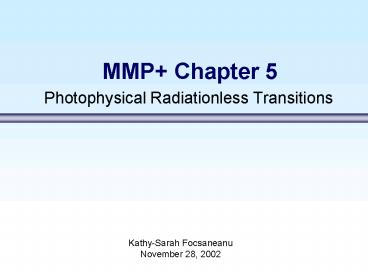MMP Chapter 5 - PowerPoint PPT Presentation
1 / 12
Title:
MMP Chapter 5
Description:
6.2 A Classical Interpretation of Radiationless Electronic ... radiationless 'jumps' occur at critical nuclear ... is easy! ( Kasha's rule) kST F IC 1 ... – PowerPoint PPT presentation
Number of Views:35
Avg rating:3.0/5.0
Title: MMP Chapter 5
1
MMP Chapter 5
- Photophysical Radiationless Transitions
Kathy-Sarah Focsaneanu November 28, 2002
2
6.2 A Classical Interpretation of Radiationless
Electronic Transitions as Jumps between Surfaces
- radiationless jumps occur at critical nuclear
geometries, rc - probability of surface jump _at_ rc is
P e-(?E/?? s)
3
6.3 Wave Mechanical Interpretation of
Radiationless Transitions between States
- adiabatic (Born-Oppenheimer) approximation
simplifies to motion of nuclei only - treat nuclei classically electrons as waves
?2? ?1? ?2 ? ?1
Initial ? mixing near rc ? Final
- mixing is needed to produce the jump
otherwise, the point will continue along original
surface - frequency of resonance called electronic
tautomerism, where - ? h/?E 10-13/?E s ?ltltlt ??
resonance region
4
- point passes through unperturbed
- if E of ?1 ?2 coupling is lt Evib, may consider
E0
- typical for ? or ? bond breaking
- no Z.O. linkage
- no dynamic coupling near rc
- jump probability varies inversely with how
strongly the crossing is avoided - occur most readily when there is little geometry
change
5
6.4 Formulation of a Parameterized Model of
Radiationless Transitions
- processes must be isoenergetic
- radiationless transitions enduced by
- mixing of n and ? orbitals by out-of-plane
vibrations (see Fig 6.6) - spin-orbit coupling, where a force is required to
change the spin this force must act while the
point is near rc
Selection Rules 1. 1n, ?? 3?, ? allowed 2. 1n,
? ?3n, ? not allowed 3. 1?, ? ?3n, ?
allowed 4. 1?, ? ?3?, ? not allowed
El-Sayeds Rules for S1?T n,? ? n, ?
Forbidden n, ?? ?, ? Allowed ?,? ? ?, ?
Forbidden
T1 ? S0 n,? ? n2 Allowed ?,? ? ?2 Forbidden
6
6.5 The Relationship of Rates and Efficiencies
of Radiationless Transitions to Molecular
Structure
Vibrational promoters of radiationless
transistions -Loose boltstrong vibration
in another part of the molecule -Free Rotor
twisting of a bond efficiency ? constraint
within molecule and within the
environment Matching Surfaces -no
intersection means no opportunity to mix
-probability is poor, e.g. ??S1?S2dr? is very
small
7
6.6 Factors that Influence the Rate of
Vibrational Relaxation
- transfer of excess energy to the environment
(solvent) is fast because the solvent behaves as
a heat bath
- electronic motion and position change
- local excited vibration
- electronic-vibrational radiationless transition
- excess energy is transferred through the molecule
to surrounding solvent molecules
8
6.7 The Evaluation of Rate Constants for
Radiationless Processes from Quantitative
Emission Parameters
- measurement of lifetimes and quantum yields
allows calculation of rate constants
9
6.8 Internal Conversion (Sn? S1, S1? So)
? absorption (S0 ? Sn)
krad S0 ? Sn
?F
knonrad Sn ? S1
kST
Zero Order crossings are common above S1 ? IC
from Sn is easy! (Kashas rule)
Ermolevs Rule
?F ?IC ?ST 1 or 1 (?F ?ST) ?
Deuterium Effect -switching C-D for C-H ?
wavenumber -as a result, ?? ? thus IC ? and
?F ?S ?
10
6.9 Intersystem Crossing from S1 to T1
- the S1 to T1 transition can occur via
- -direct S1 coupling to upper vibl levels of T1
- -coupling of S1 to Tn, followed by rapid Tn to
T1 IC - variation in size of kST from
- -amount of electronic coupling between S and T
- -size of energy gap between S and T
- -amount of spin-orbit coupling between S and T
- Temp dependence
- -krad does not vary with temp, but knonrad does
- kST obs kSTo Ae-E/RT
- -?F and ?S thus vary with temp, but not at T lt
100 K (energy term is less significant) - Triplet Sublevels
- -ISC occurs from an individual sublevel
- -processes from different sublevels have
different rate constants
11
6.10 Intersystem Crossing (T1 ? So)
- Size of kTS varies with E(T1)
- Excess energy dissipated through C-H vibrations
- Deuterium effects
- -more significant than in the singlet
- -large T1 to S0 gap smaller frequency for C-D
stretch means that many more vibrational quanta
are needed - -inhibition of ISC (enhancement of
phosporescence?) - Temp effects kTS relatively independent of temp
- Triplet sublevels k(TS0), k(T0S0), k(T-S0) may
be resolved at 4K
T1
phosphorescence
kTS
S0
12
6.11 Perturbation of Spin-Forbidden
Radiationless Transitions
- Heavy Atom effect
- -kST, kTS, kP increased by adding a heavy atom,
kF, kIC unchanged - -again, phosphorescence is a trade-off between
kTS and kP - -i.e. who wins? ?P or ?TS?
- External Perturbation
- -outside influence on spin-orbit coupling and
energy transfer - -kST obs kST kST-XX (pure
perturbation by X)

